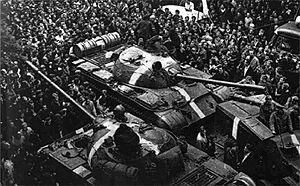Prague Spring facts for kids
The liberalisation and democratisation efforts of Alexander Dubchek and Czechoslovakia's Communist Party, known as Prague Spring, took place in 1968. As the Soviet Union thought that Czechoslovakia was moving away of communism, an alliance of Warsaw Pact countries invaded Czechoslovakia on August 20-21, 1968. Immidiately after the invasion, a series of protests took place in Czechoslovakia.
Prague Spring symbolizes the experiment of establishing of a socialism with a human face, in postwar Eastern Bloc and its violent suppression from Warsaw Pact countries in August 21, 1968. The event is included in a greater series of Cold War-related unrests. Some examples are May 1968 in France, the student protests against Vietnam War and the military junta in Greece (1967-1974).
After the invasion, the most reforms that took place during Prague Spring were reversed or halted. This period after Prague Spring is known as normalization. The only exception was the federalisation of Czechoslovakia. Czechoslovakia became officialy a federal country on January 1, 1969.
Images for kids
-
Main instigators of Prague Spring in 1968 (L–R) Oldřich Černík, Alexander Dubček, Ludvík Svoboda and Josef Smrkovský
-
Romanian Prime Secretary Nicolae Ceauşescu gives a speech critical of the invasion, in front of a crowd in Bucharest, 21 August 1968
See also
 In Spanish: Primavera de Praga para niños
In Spanish: Primavera de Praga para niños







